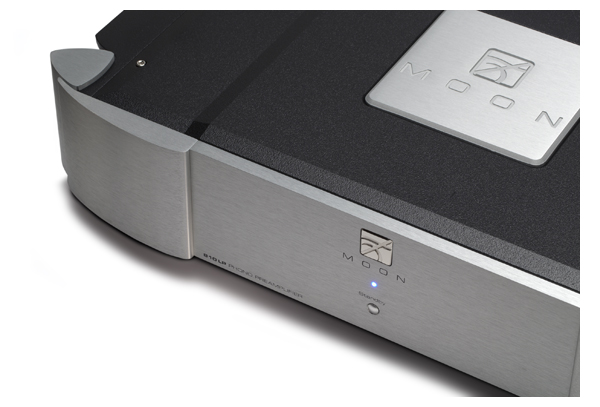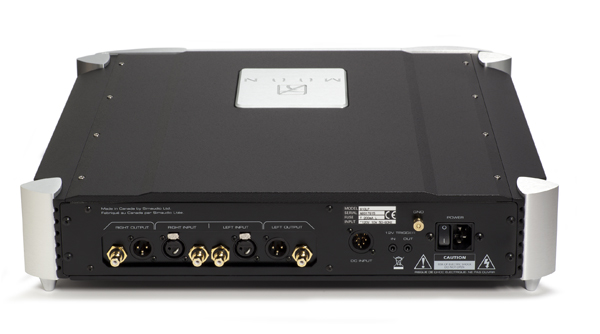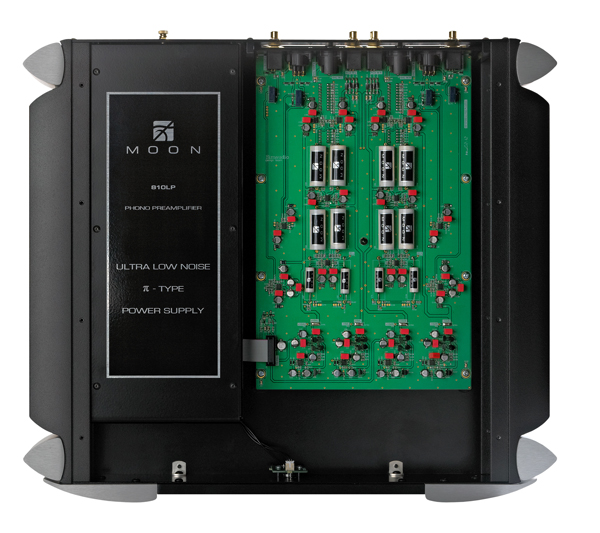Simaudio MOON 810LP Dual-Mono Phono Preamplifier
 Some audio components aspire to wow you right out of the box. They deliver thumping bass with frightening ease and highs so crystalline you wonder what details your previous piece of equipment masked. Initially, this effect can seem transcendent. But sometimes it inspires a nagging doubt about whether the gear truly offers the goods or if it has merely duped you with overemphasized frequency responses or other anomalies that have mysteriously captured your attention, only to become distracting or overbearing in the long run.
Some audio components aspire to wow you right out of the box. They deliver thumping bass with frightening ease and highs so crystalline you wonder what details your previous piece of equipment masked. Initially, this effect can seem transcendent. But sometimes it inspires a nagging doubt about whether the gear truly offers the goods or if it has merely duped you with overemphasized frequency responses or other anomalies that have mysteriously captured your attention, only to become distracting or overbearing in the long run.
Other components impress in a different, subtler way—with a certain quiet authority that doesn’t attempt to raise its voice or shout and rant. Such performance is implicit and doesn’t require the boisterous pomp and circumstance of equipment that has to slap you in the face in order to get your attention.
The Simaudio MOON 810LP Dual-Mono Phono Preamplifier falls into the latter camp. It’s not just quiet; it’s dead silent, even tomb-like. It’s also amazingly simple to operate. Just plug in the power cord, push the lone button on the faceplate, adjust a few loading features and you’re ready to go in less than five minutes. But that’s not the whole story. After all, hi-fi isn’t about convenience.
Still, I wasn’t really sure what to expect when I received the unit. What would distinguish the MOON 810LP, I wondered? A number of nifty phonostages have passed through my system over the past year, including the Pass Labs XP-25, and each has had its own set of virtues. But, of the solid-state units I’ve reviewed, the MOON 810LP possesses an absence of noise that is most enticing.
The technical prowess exhibited by Sim with this preamp did not surprise me: The company is on a roll, having produced a series of new products that offer exceptional performance at reasonable prices. Sure, anyone can achieve superior performance by pumping endless R&D dollars and cost-is-no-object componentry into a piece of equipment. But is it really worth it? In the case of the MOON 810LP, Sim has gone to great lengths to create a product that can go head-to-head with those from the likes of Boulder and other manufacturers producing stratospherically priced solid-state units.
Part of the MOON Evolution series, the 810LP boasts switchable capacitance and impedance load settings, which makes fine-tuning the MM or MC cartridge paired with the unit a bit easier. This preamp also allows users to set the load level at any of 16 steps, from 40 dB up to a whopping 70 dB. Users mandate these settings by flicking the various small switches located underneath the unit. For this review, I used the Lyra Atlas cartridge, so I ended up setting the 810LP’s gain at 66 dB, a healthy level by any measure.
The adjustability of these settings, however, is not what accounts for the low noise of the unit, which measures -150 dB at 1 volt of input power, according to Sim. A portion of the 810LP’s quiet operation can be attributed to its formidable power supply, which offers some 40,000 uF of capacitance and is located within the main chassis but housed in an isolated enclosure made out of satin-coated 14-gauge steel. Sim mounts the audio circuit board on a five-point gel-based floating suspension. While the phonostage has balanced circuitry, it can also be run single-ended. By and large, balanced operation will run quieter than single-ended, but single-ended sometimes can be perceived as possessing a little more punch.
With some preamps, it takes a little time to figure out their sonic trademarks. There was no such problem with the Sim, once powered up for 24 hours. As soon as the needle is dropped, it becomes quite apparent that the Sim likes to boogie. For example, on the recently issued Acoustic Sounds LP of Shelby Lynne’s album Just A Little Lovin’, the dynamism and jet-black backgrounds prove overwhelming. Was I stacking the deck a little by choosing this album? Sure. The production values are awesome—a tribute to Chad Kassem’s indefatigable zeal to produce the best when it comes to LPs. But the Sim brings a sense of placidity to the table, an unruffled evenness, with each note unhurried, as Lynne’s voice trails off into the ether—and the decays seem to reverberate almost endlessly. The brush and cymbal work, too, were pellucid. And I, as a result, was transfixed.
Lest TONEAudio readers think I only spun fancy new pressings for this review, please rest assured that I also listened to an old warhorse: Debussy’s “Iberia” captured on a Living Stereo pressing with legendary conductor Fritz Reiner, whose fanatic precision and attention to detail come across beautifully on the LP. Once again, the MOON 810LP stands out. This time I was most impressed with the way the low noise floor exposed the inner detail of the orchestra, which would have been submerged when played through a lesser phonostage.
It was as though the aperture of a camera had been adjusted—suddenly there was new clarity. In a sense, it became easier to listen to the music. The listener needn’t exert such effort, as the music was simply present, without struggling to emerge through a faint haze. The fog had lifted, as a dealer put it to me years ago when I was listening to an upgraded Linn LP-12 versus an older version. With the MOON 810LP, there is a lot of fog lifting.
Similarly, on a superb recording of Stephane Grappelli and Barney Kessel from Black Lion Records, the interplay between the violin and guitar is as vivid as I’ve heard it. The absence of noise helps close the noise-floor gap between CDs and LPs. Say what you want about digital sound—and I think it’s nuts to dismiss it—one of its strengths is that there is, essentially, no audible noise during playback, which helps endow the musical reproduction with a true sense of realism. Sure, when you attend a live classical concert, you hear the screeching of chairs, the neighbor next to you reaching for a lozenge, or the snoring of a bored patron—or, at a rock concert, a shouting crowd. But the one thing you don’t hear is distortion. When listening to live music, there’s no barrier between you and the sound being produced, just air vibrations traveling toward your ear canal. Now that ain’t happening in your listening room, no matter how festooned with dampening foam it might be. The whole shebang—power chords, amplifiers and preamplifiers, cables, loudspeakers—amounts to a barrier between you and the real thing. But one of the goals of audio reproduction is to move one step further toward the real thing—to reproduce it, if you will—which is what the MOON 810LP does with the utmost simplicity and clarity.
The Benefits of Being a Little Too Quiet
Now, you may ask, what doesn’t the MOON 810LP do? A comparison with the Ypsilon VPS 100, a transformer-coupled tube-driven phonostage hailing from Greece, proved instructive. After listening to André Previn’s incredibly pristine 1974 recording of Lieutenant Kijé on an EMI pressing, I switched the input on my Ypsilon preamplifier to the Sim, which revealed a completely different world. The MOON 810LP acquits itself so admirably that its great strengths are immediately apparent: low noise and a matter-of-fact sense of control. It has a certain clarity that is difficult to surpass. On the other hand, it does not offer as much detail, dynamics or ambience as the much pricier Ypsilon. With the Sim, there simply was not as much air around the instruments, such that the size of the hall in which the recording was taken seemed to shrink. But the comparison is not really a fair one. With its separate step-up transformer, the Ypsilon clocks in at around $32,000. And a solid-state preamplifier, almost by definition, is going to have different sonic traits than one filled with vacuum tubes.
Regardless, at its price of $12,000—which is not inconsiderable, but not at the nosebleed level, either—the Sim offers sensational performance, which proves that that true fidelity can be enjoyed at prices that are steep but not prohibitive. Already, even before packing it up, I’m feeling a little wistful at the very the thought of parting with the Sim. And, unfortunately, I can’t really justify purchasing another phonostage. When it’s gone I’ll undoubtedly long for the Sim’s fundamental ability to efface noise, rendering the music in real-time and thus coming closer to the sound of a master tape.
This phonostage will not allow you to take a walk on the wild side. Its mantra is control. It never loses its composure, never becomes shrill, never allows a hint of noise to emerge. It subordinates everything to fidelity to the LP. My guess is that it measures ruler flat. I also suspect that, given the care that went into manufacturing the 810LP, it will prove very reliable, which is no small matter. If you’re looking for a preamp that will impart the music with that eerily magical glow or bump up the mid-bass response, then search elsewhere. But if you’re searching for a top-notch solid-state unit that is true to the music, then auditioning the Sim is a must.
By Jeff Dorgay
Having put the MOON 810LP through its paces before sending it to Jacob, I was highly impressed with this purist design. Being a car guy, it reminded me of the original Lotus Elise Type 25 Special Editions that were sent to the US intended for club-racing purposes only and that were 500 pounds lighter than the current Elise. In essence, the Type 25 SE eliminated everything that took away from the car’s performance. The MOON 810LP takes a similar approach to audio reproduction: It offers only one input, minimal switching (all out of the circuit path) and no remote or fluorescent display to introduce noise or distortion. While I must admit to enjoying the performance of my ARC REF Phono 2, which also has these features—and found that having to jostle the Sim around to change gain and loading slightly inconvenient—most people aren’t swapping cartridges as often as I do. Audiophiles that zero in on a single cartridge and table combination will only have to do this on rare occasion when using the Sim.
Many have asked me to make the obvious yet unfair comparison between the $12,000 MOON 810LP and the $60,000 Vitus MPP-201, the latter of which has been one of my reference components for the better part of the year. Much like Jacob’s experience with the Ypsilon, the Vitus offers extreme levels of performance, with slightly more dynamic slam and even further insight into a recording than the MOON 810LP.
However, the line of diminishing returns is definitely crossed here. The MOON 810LP got me so close to the MPP with enough money left over to buy a nice pre-owned Lotus Elise that I can’t see why anyone not possessing unlimited funds would go the extra mile for the Vitus. (It should be noted that I don’t possess unlimited funds; I’m just a little nuts, which helps explains why I drive a Fiat instead of a Lotus.) Comparing the MOON 810LP with similarly priced phonostages is more realistic and more revealing. Comparing 24 bit/192khz samples of tracks captured from the Boulder 1008 or the ASR Basis (both roughly $12,000) to those captured from ARC’s REF Phono 2 and Phono 2SE proves that the folks at Simaudio in Montreal have indeed done their homework.
Winning the Quiet Game
There is no clear cut “winner,” if you will, because each of the aforementioned units offers excellent performance and each caters to a different user. The ARC offers a bit more reach-out-and-touch-it midrange, as you might expect from tubes. And its two inputs (each user-assignable via remote) lend themselves more to the vinyl enthusiast with more than one turntable and cartridge at his or her disposal. The Boulder also has two inputs, but it is the least easily adjustable of the group, requiring users to dig out the soldering iron to make changes. But the Boulder has perhaps the most bass slam of the group, though it is a bit drier through the mid-band than the others. Keep in mind that much of this can be minimized by choice of cartridge, phono cable and overall system balance.
The MOON 810LP, being the most neutral, will fit in the widest range of systems. And, as much as I love vacuum tubes, I hate replacing them, especially when this can often bring unexpected results. The MOON 810LP will sit quietly on your equipment rack and offer analog enjoyment for decades.
It also delivers tonal accuracy as well as tonal contrast, no doubt a result of its nonexistent noise floor. While we don’t perform measurements here, when comparing the MOON 810LP to the MPP with identical turntable/arm/cartridge setups, our listening panel felt the MOON 810LP was the equal of the Vitus, if not a bit quieter. There’s an additional socket on the rear panel of the Sim marked “DC Power,” which suggests that Simaudio may have an external power supply in the works. I can only imagine the jump in performance that would give this preamp.
And, if you are a music lover that does not suffer the need for constant change and is loyal to a single cartridge, the MOON 810LP should be at the top of your list. It offers class-leading performance and solid build quality.
Simaudio MOON 810LP Dual-Mono Phono Preamplifier
MSRP: $12,000
www.simaudio.com





